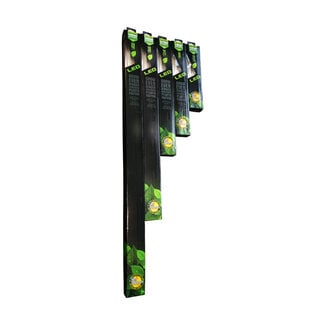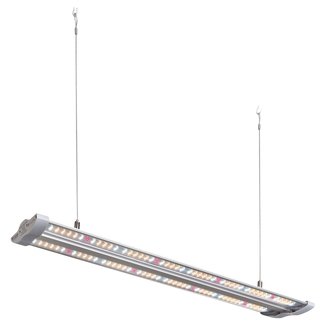T5 Grow Lights
T5 grow lights are a type of fluorescent grow light consisting of a glass tube containing argon and mercury vapor. With this T5 grow light system, metal electrodes are coated with an alkaline earth oxide that emits electrons at both ends. T5 Grow lights are typically less expensive alternatives to LEDs and are cooler and more efficient than incandescent lamps. The letter “T” in T5 refers to the lamp’s shape. The number after the “T” usually denotes the fluorescent tube’s diameter in eighths of an inch. T5 grow light has become the industry-standard for growing seedlings and greens indoors. The bulbs are 5/8″ in diameter and are some of the most efficient fluorescent bulbs you’ll find at Slims Place. In the past, T8 and T12 grow bulbs were used, but these have fallen out of favor due to the massive efficiency increase in T5 grow bulbs.
Compared to other types of lighting, T5 bulbs have a few distinct advantages.
Benefits of T5 Grow Lights
| LightWave T5 | Wattage | Lumens | Coverage area | Dimensions |
|---|---|---|---|---|
| 2ft 2-tube | 48 | 3300 | 0.6 x 0.4m | 60 x 23 x 6cm |
| 2ft 4-tube | 96 | 6600 | 0.9 x 0.6m | 60 x 27 x 6cm |
| 4ft 4-tube | 216 | 16600 | 1.2 x 0.6m | 119 x 36.5 x 6cm |
| 4ft 8-tube | 432 | 33200 | 1.2 x 1.2m | 119 x 64 x 6cm |
They’re Efficient
Fluorescent lighting is quite efficient when compared to other types of indoor lighting like high pressure sodium, metal halide, or plasma lights. And efficiency matters a lot. You’ll save money on your energy bill and get a better yield per dollar you invest in running your lights.
There are two other types of popular fluorescent tube lights out there — T8 and T12. Compared to those, T5 is the most efficient by a long shot. T5 bulbs can reach ~100 lumens per watt, which is extremely high for this type of lighting. Other types of lighting can exceed 100 lumens per watt easily, but have downsides that may make them a poor choice for your garden.
Depending on what you’re growing, fluorescent grow lights can reduce your lighting energy consumption by over 50%. When you consider those savings over the course of a year, it really starts to add up.
They Last a Long Time
Almost all fluorescent grow lights will last for 20,000+ hours. More importantly, you’ll have good bulb performance throughout those 20,000 hours, without much degradation as your bulbs reach the end of their lives. The superior lifespan of T5 bulbs is yet another factor that brings the true cost of using these lights down.
They Don’t Put Out Much Heat
As an indoor gardener, controlling your environment is crucial. And one of the most annoying factors to control is the heat of your grow room. No matter what lights you use, heat will be emitted from them which causes your grow room temperature to rise. Some of the hottest lights require dedicated cooling systems, venting, and fans to control for the massive amount of heat they produce. If you’re growing in cramped grow tents, these lights can be a fantastic option.
On the other hand, T5 grow lights run extremely cool. This means you can place them close to your plants without burning the leaves, increasing the amount of light they’re able to take in. Hotter lighting systems, like HPS or MH, need to be at least a foot (or more) away from your plants, while you can place T5 fluorescent lights just 2-6″ away.
You’ll also eliminate the need to add ducting or ventilation to remove excess heat from the garden, which are two great expenses to delete when just starting out growing plants indoors.
Types of T5 Lights
While we’ve talked mostly about T5 fluorescent lights, there is another option if you want to go that route: T5 LEDs. Let’s dive into the pros and cons of each type of T5 bulb.
Fluorescent
We’ve already talked about T5 fluorescent lights, and for good reason — they are by far the most common type of T5 fixture used for indoor gardening. Many gardeners have switched from more powerful lighting like HPS or MH in favor of T5 fluorescent lights for the benefits outlined in the section above.
On top of that, if you’re just starting out growing plants indoors, buying T5 fixtures can keep your startup costs low. This doesn’t mean to buy the cheapest T5 lights out there, but instead to buy the best quality that your budget can afford, realizing that it’s still cheaper than most other lighting options.
LED
Some growers are stuck on LEDs and want to use them in a T5 setup. This is entirely doable. You can purchase LED tubes that fit your T5 lighting fixtures and convert the entire thing over to an LED system.
The benefits here are similar to the benefits of LED lighting in general:
- Extremely low energy
- Extremely low heat
- Extremely long lifespan
Of course, no type of lighting is without its downsides, and LEDs are no exception. If you decide to go with T5 LED bulbs instead of fluorescent, you’ll have the same issues as you would with any other type of LED bulb. Also, make sure that the model you’re using works with LEDs!
Difference Between T5, T8, and T12 Lights
In the not too distant past, you could choose between T5, T8, or T12 fixtures for your garden. However, progress happens and things change. In 2012 the Department of Energy banned the manufacture of T12 fixtures simply because they are so inefficient when compared to alternative technologies. While you can’t buy new T12 fixtures, they’re still out there in the used markets and existing gardens…although i don’t know why you’d want to track them down. They’re bad.
T8 lighting is also quite inefficient when compared to a T5 grow light, so there’s really no reason to consider anything but a T5 light fixture as long as you’re set on fluorescent lighting.
How Do T5 Lights Compare to Other Types of Lighting?
T5 vs. HPS
High pressure sodium (HPS) lights hold a venerated position in indoor gardens worldwide. They’re powerful and efficient lights that can bring almost any plant from seedling to fruiting stage.
From an efficiency standpoint, most HPS lights edge out a T5 grow light, although only by about 40 lumens per watt. However, the increase in efficiency has a trade-off in the form of increased heat output. If you’re using HPS lights, you’ll need to place them further from the canopy of your garden. You may also need to vent the heat out with inline fans and ducting if they run especially hot.
On top of that, HPS lights take up more vertical space in the garden. If your growing area is small and not too high, your plants may find themselves cramped for space as they grow when using HPS lights.
If you decide on T5 grow lights instead of HPS, you’ll lose out in lumens per watt, but will have a cooler grow room with less space taken up by your lighting system. You’ll also spend less money on energy costs in the longer run, even though T5 bulbs are more expensive than HPS upfront. T5 bulbs last longer and degrade slower.
T5 vs. HID
High intensity discharge (HID) lights are another option to look into. Technically, HPS lights are in this category, but let’s take a look at the HID category in general to understand what differences lie between it and T5 lights.
HID systems are exceptionally powerful lights that require a lot of parts to build your light fixture. To run HID lights, you need:
- Bulbs
- Reflector
- Ballast
- Socket
For this additional complexity, you gain more lumens per watt, and typically a more complete spectrum of light, allowing you to run HID lights throughout the growing cycle of your plants.
No matter what type of HID lighting you choose, they will always run hotter than T5 grow lights. Again, you’ll need to deal with this excess heat somehow — ducting, venting, or fans are all good options. You simply have to pay a price for the extra power you’re getting.
With T5 bulbs, you gain space but may need to customize your bulbs to get a spectrum of light you can bring a plant to flower with. That’s one of the downsides of T5 bulbs that many people don’t talk about.
T5 vs. LEDs
Without a doubt, the biggest craze in grow lights over the past few years are LED grow lights. Their popularity has exploded, and so has the manufacture of these lighting systems.
This is for good reason — LEDs are extremely efficient, they put out minimal heat, and last for ages. Manufacturers like to talk about their 100,000+ hour lifespan, but what they fail to mention is that there is a serious drop in efficiency after about 30,000 hours or so.
You might be saying, “OK, but that’s still better than T5 grow lights, which last for about 20,000 hours.” And you’d be right, but LED lights are typically more expensive than T5s, although the price has come down slightly in the past year or two.
In the end, it will come down to your budget and your preference, especially with some newer white LED systems coming onto the market.









